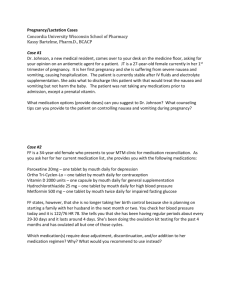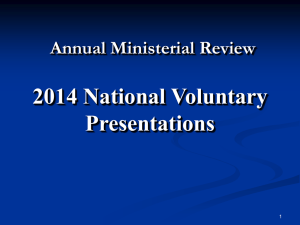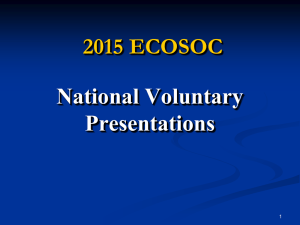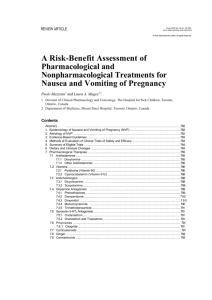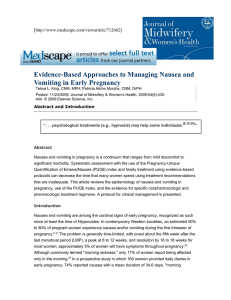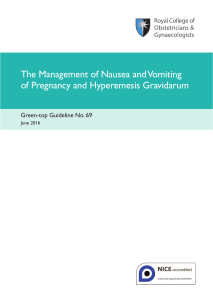Nausea and vomiting of pregnancy: Evidence
advertisement
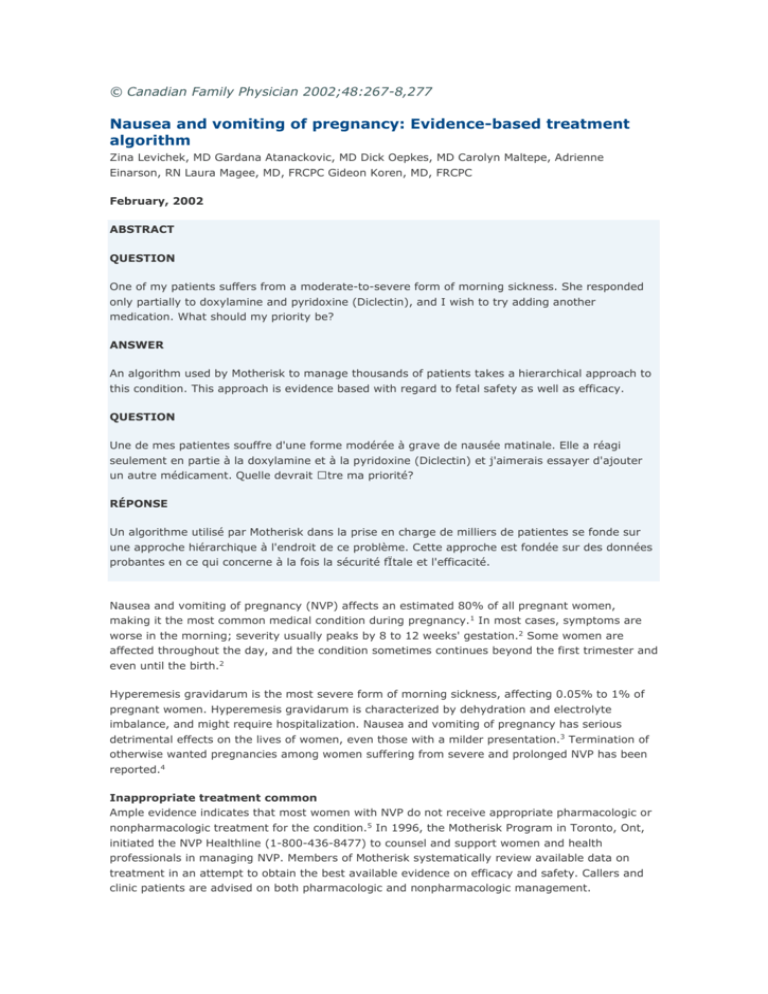
© Canadian Family Physician 2002;48:267-8,277 Nausea and vomiting of pregnancy: Evidence-based treatment algorithm Zina Levichek, MD Gardana Atanackovic, MD Dick Oepkes, MD Carolyn Maltepe, Adrienne Einarson, RN Laura Magee, MD, FRCPC Gideon Koren, MD, FRCPC February, 2002 ABSTRACT QUESTION One of my patients suffers from a moderate-to-severe form of morning sickness. She responded only partially to doxylamine and pyridoxine (Diclectin), and I wish to try adding another medication. What should my priority be? ANSWER An algorithm used by Motherisk to manage thousands of patients takes a hierarchical approach to this condition. This approach is evidence based with regard to fetal safety as well as efficacy. QUESTION Une de mes patientes souffre d'une forme modérée à grave de nausée matinale. Elle a réagi seulement en partie à la doxylamine et à la pyridoxine (Diclectin) et j'aimerais essayer d'ajouter un autre médicament. Quelle devrait •tre ma priorité? RÉPONSE Un algorithme utilisé par Motherisk dans la prise en charge de milliers de patientes se fonde sur une approche hiérarchique à l'endroit de ce problème. Cette approche est fondée sur des données probantes en ce qui concerne à la fois la sécurité fÏtale et l'efficacité. Nausea and vomiting of pregnancy (NVP) affects an estimated 80% of all pregnant women, making it the most common medical condition during pregnancy.1 In most cases, symptoms are worse in the morning; severity usually peaks by 8 to 12 weeks' gestation.2 Some women are affected throughout the day, and the condition sometimes continues beyond the first trimester and even until the birth.2 Hyperemesis gravidarum is the most severe form of morning sickness, affecting 0.05% to 1% of pregnant women. Hyperemesis gravidarum is characterized by dehydration and electrolyte imbalance, and might require hospitalization. Nausea and vomiting of pregnancy has serious detrimental effects on the lives of women, even those with a milder presentation.3 Termination of otherwise wanted pregnancies among women suffering from severe and prolonged NVP has been reported.4 Inappropriate treatment common Ample evidence indicates that most women with NVP do not receive appropriate pharmacologic or nonpharmacologic treatment for the condition.5 In 1996, the Motherisk Program in Toronto, Ont, initiated the NVP Healthline (1-800-436-8477) to counsel and support women and health professionals in managing NVP. Members of Motherisk systematically review available data on treatment in an attempt to obtain the best available evidence on efficacy and safety. Callers and clinic patients are advised on both pharmacologic and nonpharmacologic management. This paper provides clinicians with a simple evidence-based algorithm on the efficacy and safety of treatments for NVP. Rationale In planning and evaluating management of NVP, fetal safety is clearly the primary concern, followed by efficacy. This order of priorities dictates that, in general, older medications, for which there are more data on fetal safety, are preferred over newer, perhaps more effective, drugs for which there are as yet fewer data on safety. Methods The algorithm is based on a recent systematic review of the literature on safety and efficacy of management of NVP conducted by members of the Motherisk Team.6 The course of NVP ranges in severity, length, and response to treatment. We addressed treatment of NVP in a decision tree (Figure 17). It begins with pharmacologic management of relatively mild cases and progresses to treatment of patients who cannot tolerate oral treatment or are dehydrated, or both. At any stage of the algorithm, physicians can add or, when there is improvement, withdraw treatment. The systematic review6 included meta-analyses whenever the data permitted. The quality of the evidence on fetal safety and maternal efficacy varies. There is large and convincing evidence on the safety and efficacy of doxylamine and pyridoxine (Diclectin). Evidence on the safety of other H1 blockers is as strong, but evidence of efficacy is less strong. Many studies on the efficacy of phenothiazines offer convincing evidence, but the number of studies on safety is much smaller (birth defects are generally rare). Evidence on the safety and efficacy of ondansetron and metoclopramide is preliminary. The hierarchy presented in the algorithm is based on the strength of evidence for fetal safety, and only treatments shown to be efficacious were included. It has been used by the Motherisk Program for treating a large number of patients. Acknowledgment This study was supported by a grant from Duchesnay Inc in Laval, Que. References 1. Gadsby R, Barnie-Adshead AM, Jagger C. A prospective study of nausea and vomiting during pregnancy. Br J Gen Pract 1993;43:245-8. 2. O'Brien B, Zhou Q. Variables related to nausea and vomiting during pregnancy. Birth 1995;22:93-100. 3. Mazzotta P, Stewart D, Atanackovic G, Koren G, Magee LA. Psychosocial morbidity among women with nausea and vomiting of pregnancy: prevalence and association with anti-emetic therapy. J Psychosom Obstet Gynaecol 2000;21:129-36. 4. Mazzota P, Magee L, Koren G. Therapeutic abortions due to severe morning sickness. Unacceptable combination. Can Fam Physician 1997;43:1055-7. 5. Mazzotta P, Maltepe C, Navioz Y, Magee LA, Koren G. Attitudes, management and consequences of nausea and vomiting of pregnancy in the United States and Canada. Int J Gynaecol Obstet 2000;70:359-65. 6. Mazzotta P, Magee LA. A risk-benefit assessment of pharmacological and nonpharmacological treatment of nausea and vomiting of pregnancy. Drugs 2000;59(4):781-800. 7. Atanackovic G, Navioz Y, Moretti ME, Koren G. The safety of higher than standard dose of doxylamine-pyridoxine (Diclectin) for nausea and vomiting of pregnancy. J Clin Pharmacol 2001;41:842-5. ... © Canadian Family Physician 2002;48:267-8,277
![Questionnaire used in the study Demographics GENDER: M [ ] F](http://s3.studylib.net/store/data/006712173_1-21c851410b04058d524e1b79e54e32b0-300x300.png)
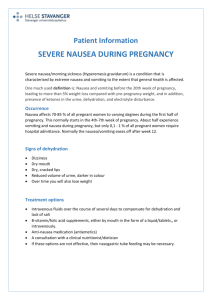
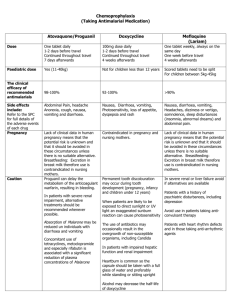
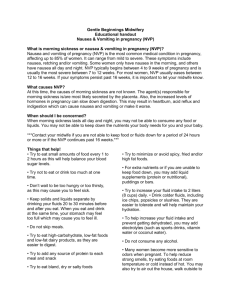
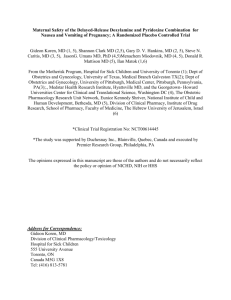
![[Physician Letterhead] [Select Today`s Date] . [Name of Health](http://s3.studylib.net/store/data/006995683_1-fc7d457c4956a00b3a5595efa89b67b0-300x300.png)
